On the grand stage of life there are lead roles and there are supporting ones. For every star there is a crew working diligently behind the scenes.
Last week I gained a new appreciation for the talent, work ethic and discipline of the professional golfer, and the surprisingly rigorous role of the caddie lugging the bag.
The event was the Tour Championship of Canada presented by Freedom 55 Financial. It was held September 8th – 14th at Sunningdale Golf and Country Club in London, Ontario and is the final tournament and crown jewel of the PGA Tour Canada circuit. Qualifiers consisted of the top sixty money winners vying for a share of the $150,000 purse with a top prize of $27,000. This no-reduction (cut) event was the last opportunity for players to earn full or limited qualification to the Web.com Tour – the next level of progression on the radar for many of these golf professionals.
There are four stages of qualification on route to the Web.com Tour. Card-carrying members of the Canadian tour are automatically exempt from the three-round Pre-qualification Stage in September. Depending on the player’s tour ranking, he may have to compete in as many as three subsequent stages involving 14 rounds at venues across the United States, from October to December.
The top PGA Tour Canada finisher gets full exemption to Web.com. Winning the honour this year was Joel Dahmen from the United States, earning $80,992 for the season. Players ranked two through 10 automatically advance to the six-round Final Stage of qualification in December at Palm Beach Gardens, Florida.
Those finishing in positions 11 to 20, on the Canadian money list, receive a First Stage exemption and join the Second Stage of qualification in November. In addition to improving the odds for success in a long and intense qualification process, exemptions mitigate some of the player entry fees, which range from $2,500 to $5,000 for each stage.
***
As a Sunningdale club member living five minutes from the course, I jumped at the organizing committee’s request for volunteers to billet a players from an international field of qualifiers. Being an avid golfer – of marginal talent but plenty of free time – the idea of hosting and following a professional around my home track for the week was exciting. It was a chance to get an up-close look at the life of a professional golfer and learn something about how world-class talents and stars of the future play the game.
A couple of days before the tournament, I learned the player that would share our home for the week would be 26-year-old, Robert Karlsson of Kalmar, Sweden (unrelated to the PGA America player of the same name and homeland). This was Karlsson’s first year on tour and he ranked 18th on the money list coming in. He was well-positioned to play his way to an exemption into the second, or even final, Web.com Tour qualifying stage with a strong finish this week.
I first met him at the driving range warming up for the Tuesday Pro-Am where he was teamed with a couple of Sunningdale members and a friend of his from the Kitchener area. At 5’9″ and 170 lbs, he’s about the size of Northern Ireland’s Graeme McDowell and not entirely unlike him in appearance. Not the biggest player in the field, but size seemed no disadvantage as I watched him work through the bag with power and precision. He finished his warm-up with a half dozen drives that soared on nearly identical flight paths towards his target.
Noticing Karlsson didn’t have a caddie for the Pro-Am, I offered to carry the bag for him. Seemingly satisfied with my assurances I routinely carry my own clubs and would be unlikely to collapse, mid-round, under the weight of his TaylorMade bag and gear, he accepted my offer. I loaded up and headed to the first tee.
For the next 18 holes, I marvelled at the simplicity of the game when drives consistently come to rest on the fairway some 280 yards out, and birdie opportunities arrive with each green routinely hit. Karlsson’s introductory round of one-under 71, that day, was peppered with a few birdies and a ‘kick-in’ eagle on the par five 1st hole (played 10th).
Having adequately managed the fundamentals in my first attempt as caddie, somewhere on the back nine Karlsson asked if I would be available and interested in carrying the bag for him at the tournament. What an opportunity!
I was about to experience my PGA Tour caddie debut.
***
For the second consecutive year at the Tour Championship, Sunningdale was hit with severe weather on the eve of the tournament. This year the storm brought 68 millimeters of rain overnight, which came in the aftermath of a 50mm downpour, just five days earlier. Considering average monthly rainfall in London since April 2014 was 80mm, Course Superintendent, Tim Webb and his team did a masterful job of preparing the grounds for play Thursday morning and maintaining it throughout the less than ideal weather conditions to follow.
***
What I Learned as a Tour Caddie
There is much more to the job than meets the eye. A caddie has two distinct areas of responsibility from the golfer’s perspective: duties of practical support and duties of professional support.
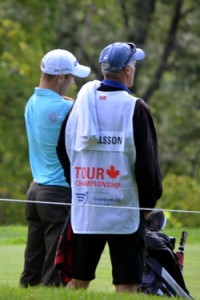 The practical aspects of the job are numerous and come in quick succession—particularly in foul weather: clubs to clean after each shot; head covers to remove and replace; balls to wipe clean under ‘lift, clean and place’ conditions; umbrellas to open, hold, carry; shots to track in flight and mark as necessary; divots to fetch, replace and tamp; a putter to produce when a shot finds the green; golf balls to wipe down on the green; bunkers to rake; flags to pull, hold and exchange, based on the player’s relativity to the hole, or a trap raking priority; putting lines to (and through) the hole to circumvent; and water bottles, bananas, and energy bars to stock and produce as required.
The practical aspects of the job are numerous and come in quick succession—particularly in foul weather: clubs to clean after each shot; head covers to remove and replace; balls to wipe clean under ‘lift, clean and place’ conditions; umbrellas to open, hold, carry; shots to track in flight and mark as necessary; divots to fetch, replace and tamp; a putter to produce when a shot finds the green; golf balls to wipe down on the green; bunkers to rake; flags to pull, hold and exchange, based on the player’s relativity to the hole, or a trap raking priority; putting lines to (and through) the hole to circumvent; and water bottles, bananas, and energy bars to stock and produce as required.
For the most part, my delivery of practical services was solid enough through the week. Granted, I almost left behind a towel and a head cover in the first round. And my employer did once have to point out a shot I had lost in flight had fallen short, into a bunker, when with the best of intentions, I offered him his putter on route to the green. And admittedly, I once lapsed into the role of golf fan and shouted “get in” at his playing opponent’s approaching chip.
But on balance, club faces and golf balls were meticulously cleaned, I never stepped on a player’s putting line, kept clear of the sightlines, remained still and quiet during shots, never bobbled a ball flipped to me for cleaning, and I kept up to the unexpectedly brisk pace of play, for twosomes.
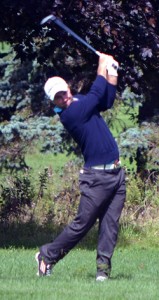 Much of the professional support applies more to a player with a permanent—or at least more experienced—caddie. In these cases there are greens to read, winds to assess, and club choices to weigh-in on. A caddie should be prepared to be a sounding board and in most game situations, respond with reassurances.
Much of the professional support applies more to a player with a permanent—or at least more experienced—caddie. In these cases there are greens to read, winds to assess, and club choices to weigh-in on. A caddie should be prepared to be a sounding board and in most game situations, respond with reassurances.
On the player’s lead, a caddie may be called into casual conversation between shots and ease tension. Or, depending on circumstances, remain silent to avoid creating it.
While I was called in on a couple of occasions for wind and line input, my role—and from what I could see, that of many volunteer caddies—was focused principally on the physical aspects of the job.
It was clear Karlsson’s routine involved pacing off distances while he checked pin placement and green undulation charts. He assessed winds and made his own club selections and he read the green from all angles to determine his putting line. His performance at the Pro-am—his first time on the course—convinced me there was very little I could offer in the area of professional support beyond what he was more than capable of cyphering for himself.
Successful putting is the perfect balance of a line seen and a speed felt. The two are inextricably linked. A putt can be successfully holed with variations of complementary line and weight. For that reason, I find there’s a difference between stepping up and making a putt, myself, and providing counsel to another on the correct line. Many a putt has been hopelessly missed in the doubt and indecision that follows three well-intentioned scramble mates offering unsolicited and disparate advice on line.
Many pins for the tournament were set in positions I can’t recall playing and greens were rolled considerably faster. I do wonder whether a more discerning eye, and confident caddie input on the idiosyncrasies of my home course greens, might have helped save Karlsson a couple of putting strokes over the week. Green characteristics, by quadrant, is something I plan to be more attentive to as I play. Hopefully that translates to improved reads and strokes saved in my own game.
***
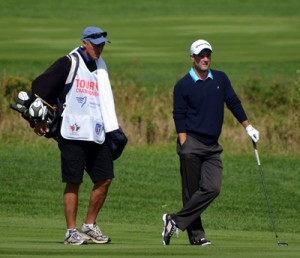 There’s a lesson to be learned from a golf pro’s attitude. At one point in the first round, Karlsson hit a high draw off the tee that turned in the breeze and hopped left on the ground. When we got to the ball, which had settled down in the rough, it was clear there would be some tree branches to negotiate, between us and the par-4 green. Having been victim to those coordinates, several times before, my off-the-cuff comment was, “I don’t like where that wound up.” With calm confidence, Karlsson responded, “we just have to find a way.” He selected a club and played a low draw around the tree that stopped just short of the green. His flip wedge to the elevated green landed softly a few feet from the pin and he holed out to save par.
There’s a lesson to be learned from a golf pro’s attitude. At one point in the first round, Karlsson hit a high draw off the tee that turned in the breeze and hopped left on the ground. When we got to the ball, which had settled down in the rough, it was clear there would be some tree branches to negotiate, between us and the par-4 green. Having been victim to those coordinates, several times before, my off-the-cuff comment was, “I don’t like where that wound up.” With calm confidence, Karlsson responded, “we just have to find a way.” He selected a club and played a low draw around the tree that stopped just short of the green. His flip wedge to the elevated green landed softly a few feet from the pin and he holed out to save par.
I immediately resolved—for the remainder of my caddying assignment and for my own game—not to focus on the negatives of a shot already played, but to concentrate on finding a way.
The most important shot in golf is the next one
– Ben Hogan
***
“These guys are good” is the popular promotional slogan of the PGA Tour (America). No question about it. But it seems to me there is a vastly disproportionate remuneration-to-talent reality between tours. Having seen up close, the quality of play by Canadian tour professionals in the Tour Championship at Sunningdale over the last two years, I wonder how much better the players on the big tour really are?
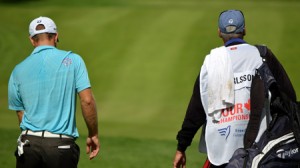 I asked a couple of the players and caddies that question over the course of the week. Karlsson, who fired two 65’s and a 66 on the way to a 20-under score and a third place finish at the SIGA Dakota Dunes Open in Saskatchewan, in July, suggested the difference may be as few as two or three shots a tournament.
I asked a couple of the players and caddies that question over the course of the week. Karlsson, who fired two 65’s and a 66 on the way to a 20-under score and a third place finish at the SIGA Dakota Dunes Open in Saskatchewan, in July, suggested the difference may be as few as two or three shots a tournament.
An experienced caddie I spoke with alluded to a level of mental toughness that develops with experience at the higher competitive level. Another view was that the stroke differential was likely found in putting stats, rather than in the tee-to-green game. Whatever the case, the corresponding prize money between the two tours is astounding.
To illustrate, this year’s Canadian Tour Player of the Year, Joel Dahmen, with a scoring average of 69.09, had two wins and a second on his way to $81,000 in earnings. Rory McIlroy collected $8.3 million for his three wins and two second place finishes on the strength of a 68.83 scoring average. While there may be an argument in the relative length and degree of course difficulty, the scoring difference between the top players of the respective tours, is just over a stroke a tournament. It’s a disparity that highlights an intensely competitive occupation and the fine line between having the talent, and being able to win a spot on the stage that offers the chance for a lucrative career.
The role of volunteers is critical. The success of a golf tournament depends heavily on the work of volunteers who give up a week of their time to ensure things run smoothly. While some members at any private club may begrudge disruption to personal playing opportunity with an event of this sort, I suspect most are proud of a home club awarded such a prestigious event and take full advantage of the week. It was a pleasure to hear firsthand, the many comments about the quality of the golf course, clubhouse, staff and volunteers.
It’s a rare opportunity to witness a professional golf tournament on your own course, or to participate actively in a volunteer position. There are people required for: Registration Desks, Walking Scorers, Leaderboard Operators, Standard Bearers, Shuttle Drivers, Player Relations, Marshalls, Forecaddies, Media Services, Water Support, and assorted other duties.
The players and caddies are always on the move and while the wet, windy, and cold weather of the week was less than convenient, I was never particularly uncomfortable. I empathized with volunteers who were stationary and they did wonderful work under challenging conditions. I was also impressed and grateful for the friendliness, politeness and appreciation expressed to tee attendants, forecaddies, scorers, and other volunteers we encountered, by Karlsson and his playing partners as we moved through the course each day.
***
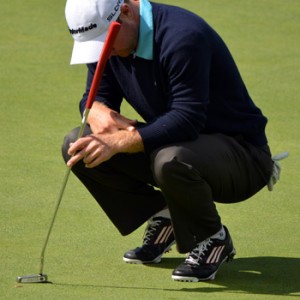 It’s “play well,” not “good luck.” Sometimes the game of golf will yield birdies and sometimes it won’t. Though one-over-par through three rounds, Karlsson could easily have been four or five strokes under heading into Sunday. This week, his putts burned the edges and chips and sand shots settled excruciatingly close to the target. This was in contrast to playing partners who made some bombs on the green and on a couple of occasions, pitched in from off it. That’s how the game goes.
It’s “play well,” not “good luck.” Sometimes the game of golf will yield birdies and sometimes it won’t. Though one-over-par through three rounds, Karlsson could easily have been four or five strokes under heading into Sunday. This week, his putts burned the edges and chips and sand shots settled excruciatingly close to the target. This was in contrast to playing partners who made some bombs on the green and on a couple of occasions, pitched in from off it. That’s how the game goes.
Many golfers on this tour travel the country together over the course of the season and have formed strong bonds of respect and friendship. The standard exchange among players before a round is “play well,” not “good luck.” While luck, in one form or another, finds it’s way into the outcome in golf, players understand that it’s a game where consistency and success comes from well executed shots and good decisions.
It’s a funny thing, the more I practice the luckier I get
– Arnold Palmer
On the back nine of Sunday’s round, Karlsson’s tee shot on the par five 15th hole drew to what looked to be a few yards into the rough. The forecaddie had marked the ball on line with a tree but was unable to locate it by the time we reached the area. A group of players, caddies, officials and fans exhausted the five minute allotment searching without success and concluding it had imbedded below the surface in an extremely wet area of the rough, Karlsson headed back to hit three-off-the-tee, ultimately recording a double-bogey, seven. After the round, when I commented on the misfortune, Karlsson was circumspect, “yeah, but it didn’t change the overall outcome … and I shouldn’t have hit it there anyway.”
***
The Tour Championship was won by 33-year-old, Ryan Williams from Surrey, British Columbia, with a four-under 68 in the final round and a tournament total of 14-under. His 18th hole par was enough to secure a one-stroke victory over fellow Canadian Adam Cornelson and final group partner, Clayton Rask from Elk River, Minnesota, who bogeyed the final hole.
***
In the end, Karlsson said the physical and mental exhaustion of driving across the country and competing in 11 events, caught up with him. Part of his head, he said of Sunday’s round, “was already on the plane home.” With a disappointing final round of 79, he slipped from 18th to 22nd position on the Order of Merit and fell short of his goal for partial Web.com exemption.
While we talked over lunch and a beer afterwards, I was impressed with how Karlsson was already putting this tournament behind him and looking forward. “I’ll be back in Sweden tomorrow and I’ll have 11 days to relax before preparing for the qualification,” he said. “I’ve learned a lot this year and have a much better understanding of my game and the work I have to do.” I suspect with a new perspective following some well-earned downtime, he will also be proud of what he was able to achieve this year.
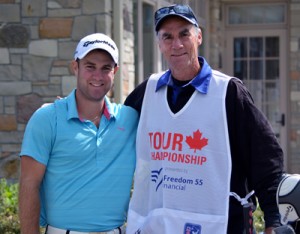 In his first year as a pro, Karlsson placed 22nd of the 297 players registered on the Canadian tour and he’s proved he can take it low.
In his first year as a pro, Karlsson placed 22nd of the 297 players registered on the Canadian tour and he’s proved he can take it low.
Spending the week with us, I’ve seen his dedication to fitness and healthy diet. As his caddie for most of a week, I’ve witnessed the work he puts into tournament preparation and the discipline of his practice. There is no question about the quality of shot making and the positive attitude he brings to the golf course. I watched him put in hours of meticulous post-round work at the range and putting green.
It was a pleasure to have Robert Karlsson share our home for a week and an honour for me to carry the bag for him. If his path should lead him back to London for Sunningdale’s third hosting of the Tour Championship, next September, he will have an open invitation to a room in our home and someone to carry the bag, if he needs it.
But my suspicion is Karlsson will earn qualification to the Web.com Tour by the end of this year and I will be following his progress, with great interest, on that tour and beyond it.
Once again, Robert will just need to find a way. Play well, pal.
*****
* photos by Sue Coyle


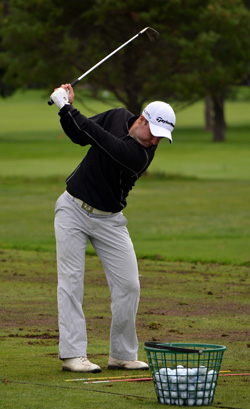
A revealing insight into the role of the caddy and also of this rising young player, especially noted is his strong positive attitude – a very enjoyable read my Friend.
Thanks buddy. It was a great experience and a pleasure to meet such a talented and personable player of the game we love. Think I even picked up something useful for my own game!
It was a good read from start to finish. Well done Derrick. I’ll be sure to try and follow Robert’s progression onto the other tours.
Appreciate it Denis. Next step is first stage of Web.com qualification in Florida, mid-October.
Great article Derrick, very well written and totally interesting from start to finish. Lots of fun reading, especially having been part of the scrambles you mentioned. I think I see either a future in writing, or caddying. The possibilities are endless.
Thanks Val. Of the two, I think Robert would politely recommend it be writing, but it sure was a great experience 🙂
Another good read Derrick. What a cool experience that must have been. Your “get in” moment for the opponent’s shot made me laugh. I remember doing the same caddying as a kid. I’ll bet your enthusiasm and course expertise did not go unnoticed. Cheers.
Thanks Tom. It was great to get a look at the profession from inside the ropes. I have a new appreciation for how hard these guys work to be that good!